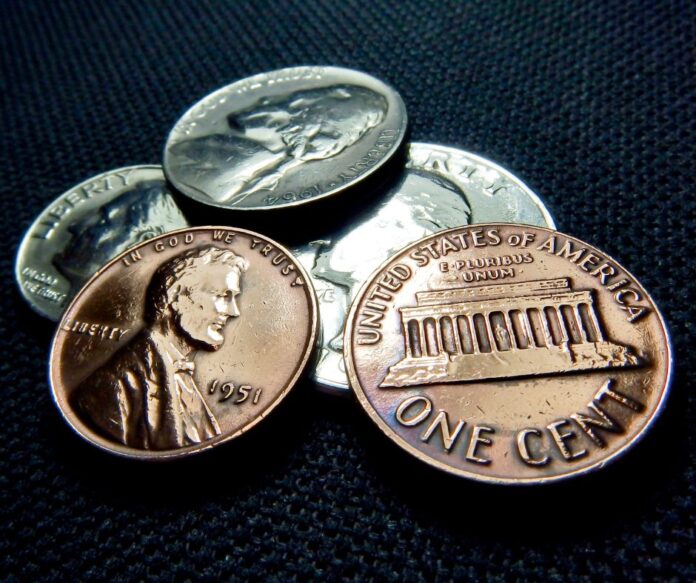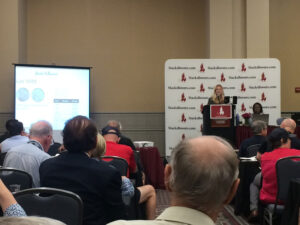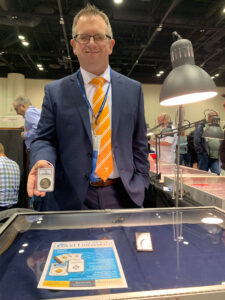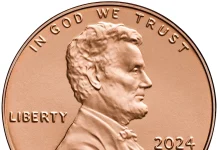
The auction scene in 21st-century numismatics is not on the carpeted floor of a hotel or convention center room, but in coffee shops, office cubicles, and backyard patios. It’s a time and place where even the most storied rarities are not sold with the flick of a paddle or thumbing of the nose, but with a click of the “ENTER” button or tap of a phone screen. It’s not for everyone. Anyone so inclined can step into an auction held in conjunction with any major coin show and still find a busy lot-viewing room or bustling live floor. But attending the landmark auctions of today no longer requires someone to buy an expensive plane ticket, put up in a hotel and then hustle into an auction room. Some wouldn’t have it any other way. Others would.

COURTESY OF THE UNITED STATES MINT
Getting Started
The first online auctions were held via email and bulletin boards, where sellers described items in a post, set a minimum bid, and the time bidding closed – a system that first hit the virtual realm in the late 1970s. Auction websites came to the fore in 1995 with Onsale.com and eBay.com, the latter taking a stronghold in the retail sector and, alongside Amazon.com, became one of the largest e-commerce players in the world. As the growth of online auctions occurred during the second half of the 1990s, numismatic pioneers took note and began building online auction platforms tailored for coin collectors.
Some of the biggest numismatic players to embrace online auctions are companies that already gained an enduring following for their live sales. Other companies built their business around online auctions, with GreatCollections.com rising to the occasion on that front. Then there are organizations such as David Lawrence Rare Coins, a dealer that carved a niche with its online auctions. Each does what they do well, and all embrace the reality that the numismatic marketplace of the future is already here – and it’s found online.
A Thrill for all Ages
“People are much more comfortable bidding online,” said Paul Minshull, chief operating officer, and chief technology officer of Heritage Auctions. “They don’t have to get dressed, drive, park, and wait for their lots. They can get a text alert, login, and bid, then go back to work, family time, or the leisure activity of their choice. It’s easier.” The customers show their love for the online bidding platforms through their feedback. Minshull reported customers telling him and his team “online auctions save me time!”
It’s not just the under-30s raving over digital auctions. Minshull asserted they are popular across all age groups and income categories. “Every age group has embraced online auctions – some even comfortably bidding on seven-figure items.”
But why are online auctions all the rage anyway? Some will chalk it up to the pandemic. But the reality is that the pandemic only hastened a virtual evolution that was already well underway.
“Interestingly, the attendance of live auction events had decreased dramatically, even before Covid,” remarked John Brush, president of David Lawrence Rare Coins. “If I’m bidding on a major rarity for the [Dell Loy] Hansen Collection, I prefer to bid in-person. However, in a live auction, you can’t place a high hidden bid without doing so in advance. In an internet auction, you can place whatever number you want, but if bidding in person, if you say “$10,000” you’re on the hook for $10k.”
Busy multibillionaire collectors like D.L. Hansen have things to do besides bidding on coins. “Dell Loy has told me many times that he doesn’t have time to sit through all of these incredibly long, boring events. ‘Please help me so I can have dinner…’”
Online Auctions Raise Their Hand
Online auctions are proven moneymakers for auction firms looking to expand their clientele. Coin auction events are now held online in tandem with live floor bidding. The fusion has even the U.S. Mint taking notice.
A recent example was the sale of the American Eagle at Dusk and at Dawn 35th Anniversary Coins by Stack’s Bowers Galleries which was tapped by the U.S. Mint to sell the last batch of American Eagle one-ounce gold and silver coins bearing their original designs and the first run of these popular bullion offerings carrying their new motifs released in 2021.
The coins fetched beaucoup bucks. The first-ever 2021 American Gold Eagle struck with its new reverse design took $100,000 (no buyer’s fees were assessed in this sale), while the last-ever 2021 American Silver Eagle with its vintage-1986 design went for $85,000. The first 2021 American Silver Eagle with the current motif hammered for $80,000, and the last of the classic 2021 American Gold Eagles flew the coop for $77,500.
“The American Eagle at Dusk and at Dawn 35th Anniversary Coins event was truly a lot of fun, and the Stack’s Bowers team really enjoyed hosting U.S. Mint Director Ventris Gibson and her associates,” remarked Stack’s Bowers Galleries Executive Vice President Christine Karstedt. “Serious floor bidders were present in the auction gallery and multiple phone bidders competed with a tremendous amount of internet participation.”

COURTESY OF JOSHUA MCMORROW-HERNANDEZ
Studio Atmosphere
Today, what helps define one auction over another is the experience. Major coin auction players are crafting innovations that capture the excitement of live floor bidding in an enhanced virtual world.
“Our mission has been to bring the excitement of a live sale to the online events with a state-of-the-art television studio and live auctioneer that makes participants feel like they are literally in the room bidding,” said Karstedt. “With online sales, we can try new things, offer smaller specialized collections, and keep online auction presentations fresh and exciting.”
Minshull at Heritage Auctions remarked their events “now look more like a TV studio with multiple cameras” and is unveiling other features to create a you-are-there experience for the online bidder. “We will be adding live features that are relevant to the audience as we go, such as more engagement with third-party chat groups during the auctions.” Yet, amid all the tweaks and enhancements to its patented Heritage Live platform, he says that the thrill behind any auction is about what’s being sold. “Mainly it’s about presenting interesting items for folks to bid on.”
Better Photos
Brush creates more interest in his items through innovative photography. “We’ve invested so heavily in our nuTilt program that allows you to experience a coin in hand virtually,” he said. Brush also says that implementing technology is “the key” to making online bidding less stressful. “As a buyer, I absolutely hate being “sniped” at the last minute. That’s why we simulate a live auction experience with added time on our auctions when a bid is placed at the last second.”
When & Where
Said Ian Russell, “Consistency and diversity are the two key aspects of GreatCollections.com.” His Irvine, California, company sells everything from Lincoln cents and Morgan dollars to California territorial gold and modern Bitcoins. “The consistency of their auction schedule, which involves a large sale each week with bidding ending on Sunday, is fundamental to GreatCollections.com’s success. “[It] means that our bidders know what to expect each week and they plan accordingly.”

COURTESY OF JOSHUA MCMORROW-HERNANDEZ
A Matter of Trust
The bidding wars aren’t going anywhere – they’re only heating up. “In the past, when bidding on the floor, you could see who else was bidding and act accordingly,” noted Minshull. “Now, we have people sitting in the audience of a live auction and using their phone or tablet to bid so no one else can see they are bidding.”
Regardless of future trends, upholding fundamentals, such as trust and ethics, will help companies survive. “Heritage regularly has people place bids worth many thousands (even millions) of dollars online and then go to dinner. They know they will not pay more than the next highest increment we receive. That trust has been well earned over many years.”
More Participation
Not only does the online model afford convenience for the bidders it can also help consignors score bigger profits. “Let’s remember that even if you were quarantined with COVID-19, with the increased online auction presence, you could still participate and bid from home. More participation drives higher prices realized.”
Russell said that he and his team at GreatCollections.com have noticed online auctions are bringing more participation, especially with young people, which form a large part of his clientele. “They love the ability to search thousands of coins, review high-quality images, and do research from their home before deciding to bid. They do it in their own time as our website is always accessible.”
As Brush sees it, there are some things about attending a show or an auction in person that at one time couldn’t be replicated online. “You missed out on the relationships with the folks at the auction company,” he said. “But these relationships are being forged differently now. The unique attributes of online auctions are simply this: comfort and value.”
This article about online auctions previously appeared in COINage magazine. To subscribe click here. Article by Joshua McMorrow-Hernandez with Anthony Swiatek














